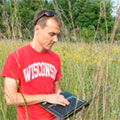research
EXPERTS
Christopher Kucharik
Associate Professor
Agronomy, Nelson Institute Center for Sustainability and the Global Environment
Steven Loheide
Associate Professor
Civil & Environmental Engineering, Geological Engineering, and Freshwater and Marine Sciences
Eric Booth
Assistant Research Scientist
Agronomy and Civil & Environmental Engineering
Evren Soylu
Postdoctoral Researcher,
Project Engineer LimnoTech
Samuel Zipper
Freshwater & Marine Sciences, PhD
Related Video
groundwater and agriculture

Agriculture is important in the Yahara watershed and interacts with the region's groundwater supply. This supply is changing due to trends in weather, municipal pumping, land use, and farming practices, which could affect crop access to groundwater and, in turn, the region's capacity to grow food.
Our groundwater and agriculture research team pursued a understanding of how crops respond to varying groundwater levels now and over time. Such knowledge will be critical to helping farmers produce food even more efficiently on their land, especially as human populations expand.
What we asked
- When, where, and how does shallow groundwater affect agricultural production? Are these relationships the same across different types of soil?
- How will changes to future land use and climate impact the distribution of groundwater and, thus, alter the relationships between groundwater level, agricultural production, and soil?
What we found
- When people think of groundwater and agriculture, the usual focus is on irrigation. However, our research shows crop yields can respond strongly to shallow groundwater, or groundwater that is close to the surface, even in the absence of direct pumping
- Shallow groundwater can subsidize water availability during drought and enhance crop yield, but when groundwater becomes too shallow, such as during flooding, it limits oxygen availability to roots and harms crop productivity.
- Land-use change in a single location, such as urbanization, drastically alters the water balance of that piece of land and the ecosystem services it can provide. We found the effects of land-use changes in one location can also extend across the landscape by changing how the groundwater flows horizontally underground and thus affecting crop productivity at locations elsewhere in the watershed.
- Targeted management of shallow groundwater at the landscape scale and active tile drainage at the field scale could help close the “yield gap” - between maximum potential crop production and actual production - thus improving efficiency in agriculture.

RESEARCH HIGHLIGHTS
High water tables can be a boon to crop yields
For crops, shallow groundwater can be a boon or a bane








